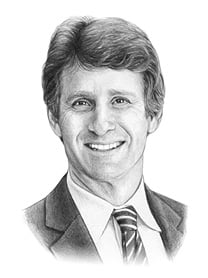Latin America Jumps up the Priority List

Analysis
Latin America Jumps up the Priority List
Ten thinkers on the start of the U.S. president’s second term.
Klawe Rzeczy illustration for Foreign Policy/Getty Images
This article is part of a collection on the second-term president’s approach to the world. Read the full package here.
U.S. President Donald Trump’s fixation on mass deportations in his first 100 days has flung Latin America up the foreign-policy priority list. Under other circumstances, that attention might be celebrated. After all, it’s rare that a U.S. secretary of state makes their first international trip to the region, as Marco Rubio did in February when he visited Panama, El Salvador, Costa Rica, Guatemala, and the Dominican Republic.
But one of Rubio’s goals on that trip was to lay the groundwork for deportations to a maximum-security prison in El Salvador. The United States later transferred migrants there, alleging that they were gang members, even though most had no criminal records in the United States and appeared to be accused based on little more than their tattoos.
U.S. President Donald Trump’s fixation on mass deportations in his first 100 days has flung Latin America up the foreign-policy priority list. Under other circumstances, that attention might be celebrated. After all, it’s rare that a U.S. secretary of state makes their first international trip to the region, as Marco Rubio did in February when he visited Panama, El Salvador, Costa Rica, Guatemala, and the Dominican Republic.
But one of Rubio’s goals on that trip was to lay the groundwork for deportations to a maximum-security prison in El Salvador. The United States later transferred migrants there, alleging that they were gang members, even though most had no criminal records in the United States and appeared to be accused based on little more than their tattoos.
Despite the indiscriminate nature of these deportations, many Latin American leaders are facilitating them—and not only those who seek a close relationship with Trump. This in part continues a trend of regional governments emulating the United States’ restrictive immigration policies. It also reflects that Latin American governments want to preserve their political capital for countering another of Trump’s policies: economic pressure.
Trump quickly threatened 25 percent tariffs on Mexico, only partially backing down after major concessions. In Panama, Trump coupled warnings about economic engagement with China with threats to take over critical infrastructure. And though Rubio has said he wants joint economic prosperity in the Western Hemisphere, few details have emerged about a positive economic agenda for the region.
The United States is more important for total trade and investment in Central America and Mexico than in South America, where China accounts for more of the economic pie. Trump’s pressure on Latin America to shun relations with China is familiar; but during his first term, many South American countries rejected that pressure and even doubled down on economic ties with Beijing.
In the face of Trump’s dramatic new trade barriers, Latin American countries are getting more creative. The Mercosur trade bloc has moved closer to a long-stalled trade agreement with the European Union; even Mexico City is in trade talks with Brussels. Presidents from the region were feted with state visits in India and Japan in recent weeks. So far, at least one effect of Trump’s second term has been to inspire countries toward trade diversification.
Catherine Osborn is the writer of Foreign Policy’s weekly Latin America Brief. She is a print and radio journalist based in Rio de Janeiro. X: @cculbertosborn
More from Foreign Policy
-

An illustration shows a line of large shopping carts facing down a small Donald Trump figure holding two shopping bags. The stars of China’s flag are in the upper left corner. Why Beijing Thinks It Can Beat Trump
China’s elites have a new confidence in their own system.
-

U.S. Army Chief of Staff Randy George speaks to U.S. soldiers at the Hohenfels Training Area in southern Germany on Feb. 6. A Drawdown of U.S. Forces in Europe Is All but Certain
Here’s how the Pentagon can rebalance its approach to the continent without sacrificing U.S. interests.
-

University of California, Los Angeles students, researchers, and demonstrators rally during a “Kill the Cuts” protest against the Trump administration’s funding cuts on research, health, and higher education in Los Angeles on April 8. Why Authoritarians Attack Universities First
A Yale professor and expert on fascism talks about why he’s leaving the United States under Trump.
-

Dwight D. Eisenhower looks over a piece of paper while sitting on a couch as Robert Cutler looks over his shoulder. How Generations of Experts Built U.S. Power
And now Trump is throwing it all away.








Join the Conversation
Commenting on this and other recent articles is just one benefit of a Foreign Policy subscription.
Already a subscriber?
.
Subscribe
Subscribe
View Comments
Join the Conversation
Join the conversation on this and other recent Foreign Policy articles when you subscribe now.
Subscribe
Subscribe
Not your account?
View Comments
Join the Conversation
Please follow our comment guidelines, stay on topic, and be civil, courteous, and respectful of others’ beliefs.
Change your username |
Log out
Change your username:
CANCEL
Confirm your username to get started.
The default username below has been generated using the first name and last initial on your FP subscriber account. Usernames may be updated at any time and must not contain inappropriate or offensive language.